Notwithstanding contention regarding the assessment methods of various global surveys, it is true that India’s high prevalence of stunting, wasting, and anaemia continues to pose public health risks for children and women. India must strengthen its existing social sector schemes, such as the Integrated Child Development Services (ICDS), to tackle this. The ICDS targets children aged 0-6 years, pregnant women, and lactating mothers; addresses non-formal pre-school education; and breaks the cycle of malnutrition, morbidity, and mortality.
What studies show
Empirical research highlights the correlation between early-life poverty, malnutrition, and inadequate stimulation, and later cognitive and economic challenges. Studies have shown that interventions focusing on nutrition, education, and health during early childhood can significantly improve human capital, particularly in developing countries. A study published in World Development demonstrated the ICDS’s positive impact on cognitive achievements, especially among girls and those from economically disadvantaged families. Another peer-reviewed study in The University of Chicago Press Journals found that children who were exposed to ICDS during the first three years of life completed 0.1-0.3 more grades of schooling than those who were not. In a study published in the Natural Library of Medicine, it was found that adolescents aged 13-18, who born in villages with proper ICDS implementation, showed a 7.8% increased likelihood of school enrolment and completed an average of 0.8 additional grades compared to their peers who did not have access to the ICDS.
As we commend the remarkable strides made by ICDS, it is imperative to acknowledge the pressing need for a thorough reassessment of our approaches. Despite four decades of relentless efforts, the ICDS still faces the herculean task of ameliorating the nutritional and health outcomes for children aged 0-6 years.
A significant first step towards fortifying the programme is to empower Anganwadi workers. Though the cornerstone of the ICDS, they are frequently stretched beyond their limits. As principal operatives in the Poshan 2.0 initiative, these workers bear the onus of advancing child nutrition, health, and education in their communities. Their roles vary widely from employing modern technology, like smartphones and applications, to practical tasks such as delivering health education, managing feeding programmes, and liaising with auxiliary nurse midwives and other healthcare professionals.
Advantages of more workers
An additional Anganwadi worker could be added to each of India’s 13,99,661 Anganwadi centers to lessen the load of these workers. Implementing this approach could yield at least five advantages. First, it would lead to better health and educational outcomes. A large-scale randomised controlled trial by Alejandro Ganimian, Karthik Muralidharan and Christopher Walters in Tamil Nadu, conducted to evaluate the effects of increasing staff levels within the ICDS framework, revealed significant outcomes. The addition of a half-time worker effectively doubled the net preschool instructional time, which led to improvements in math and language test scores for children enrolled in the programme. Second, children who remained enrolled also exhibited reduced rates of child stunting and severe malnutrition.
Editorial | Playing with learning: On status of early childhood education
Third, the cost of a nationwide roll-out of this model is relatively insignificant in comparison to the potential advantages it offers. The estimated long-term benefits, based on expected improvements in lifetime earnings, would be around 13 to 21 times the expenses.
Fourth, the new Anganwadi worker can be given the responsibility of concentrating only on preschool and early childhood education. This would allow existing workers to dedicate more time to child health and nutrition. It would also enable the Anganwadi workers to expand their outreach and serve a larger number of families.
Fifth, apart from improving the well-being of rural communities, this would create job opportunities for local residents, particularly women. It would lead to the creation of 1.3 million new jobs for women across India.
The operationalisation of the Saksham Anganwadi and Poshan 2.0 proposal hinges on its status as a Centrally Sponsored Scheme. State governments oversee its execution, including administration, management, and monitoring. Consequently, Anganwadi worker recruitment falls under their jurisdiction, guided by regulations and region-specific criteria. This decentralised approach promotes tailored, efficient implementation. The Government of India provides funds for Anganwadi workers’ and helpers’ honorariums on a cost-sharing basis.
Also read | MGNREGS workers will build almost 75% of anganwadis in 2023, says Women and Child Development Ministry
Apart from this, the data have shown a significant variation in implementation of the ICDS and the level of skills of Anganwadi workers. This requires further investments in the training programme. Additionally, the exigency for infrastructural improvement in India’s Anganwadi centers cannot be overstated. A disconcerting 2.5 lakh centres operate without functional sanitation facilities and 1.5 lakh centres lack access to potable water. Approximately 4.15 lakh Anganwadi centers do not possess their own pucca building.
To unlock the ICDS’ full potential and address persistent issues, it is essential to revisit and re-evaluate its strategies and implementation. Empowering Anganwadi workers is just a start.
Bibek Debroy is Chairman of the Economic Advisory Council to the Prime Minister; Aditya Sinha is Additional Private Secretary (Policy and Research), Economic Advisory Council to the Prime Minister







